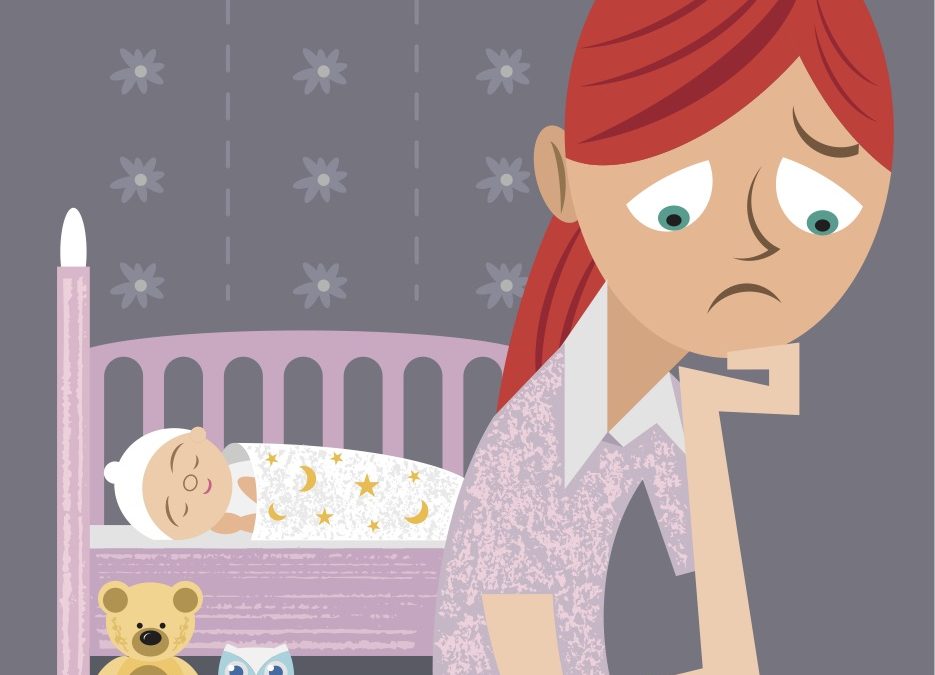Postpartum Depression (PPD) is a serious mental health condition that affects many new mothers. It is characterized by the onset of depressive symptoms during pregnancy or within the first four weeks after childbirth. This definition, as outlined in the Diagnostic and Statistical Manual of Mental Disorders, Fifth Edition (DSM-5), recognizes that the disorder can begin during pregnancy and extends beyond the immediate postpartum period.
What are the symptoms of PPD?
- severe fatigue
- tearfulness
- problems with sleep, either loss of sleep or sleeping too much
- disinterest in the baby
- memory issues
- irritability, agitation or anger
- anxiety
- loss of pleasure
- problems with concentration
- racing thoughts
- thoughts about hurting yourself or the baby
What factors can cause PPD?
- untreated depression during pregnency
- history of psychiatric illness
- genetic factors
- hormone level changes after childbirth
- first-time motherhood
- very young motherhood or older motherhood
- sleep deprivation
- fatigue secondary to caring for the baby
- stressful involved in managing new life changes
- emotional distress such as grief
- finantial problems
- isolation and luch of social support
Diagnosis and Treatment
Diagnosis and Treatment of Postpartum Depression (PPD) involves several key components based on recent research findings:
Diagnosis
Diagnosis of PPD includes a comprehensive evaluation process:
– Careful history taking, including screening for risk factors such as previous depression, stressful life events, and lack of social support (Gibson et al., 2009).
– Identifying coexisting psychiatric disorders, as PPD often co-occurs with anxiety disorders (Molyneaux et al., 2015).
– Considering medical and psychosocial factors that might impact the onset of PPD, such as pregnancy complications and relationship satisfaction (Brown et al., 2021).
– Administration of the Edinburgh Postnatal Depression Scale (EPDS), a widely used screening tool. However, its diagnostic accuracy varies across settings, with sensitivity ranging from 34% to 100% and specificity from 44% to 100% (Gibson et al., 2009).
Treatment
Treatment approaches depend on the severity of PPD symptoms:
Psychological Therapy
For mild to moderate symptoms, psychological interventions are recommended:
– Cognitive Behavioral Therapy (CBT) has shown effectiveness in improving PPD symptoms. Meta-analysis results indicate that CBT is associated with better EPDS scores compared to control groups in both short-term (mean difference = -2.86, 95% CI: -4.41–-1.31) and long-term (OR = 2.00, 95% CI: 1.61–2.48) outcomes (Brown et al., 2021).
Pharmacological Treatment
For moderate to severe symptoms or when psychological therapy alone is insufficient:
– Antidepressant medication, particularly selective serotonin reuptake inhibitors (SSRIs), is recommended. A systematic review found that SSRIs may be more effective than placebo in treating PPD, with higher response rates (55% vs 43%; RR 1.27, 95% CI 0.97 to 1.66) and remission rates (42% vs 27%; RR 1.54, 95% CI 0.99 to 2.41) (Brown et al., 2021).
– SSRIs have shown a reduction in depressive symptoms compared to placebo (standardized mean difference -0.30, 95% CI -0.55 to -0.05) over 5 to 12 weeks of treatment (Brown et al., 2021).
It’s important to note that treatment decisions should consider the potential benefits and risks of medication, especially for breastfeeding mothers, as well as the risks of untreated depression for both mother and baby (Molyneaux et al., 2015).
How prevalent is PPD?
Postpartum Depression (PPD) affects a significant proportion of new parents, with prevalence rates varying across studies. Recent research indicates that PPD is not limited to mothers but also impacts fathers, though the data on paternal PPD is less extensive.
Prevalence in Mothers
The prevalence of PPD in mothers ranges from 10% to 20%, depending on the population studied and the assessment methods used (Gavin et al., 2005). In high-income countries, the rate is typically around 10-15%, while in low-income countries, it can be as high as 20% (Woody et al., 2017). These figures suggest that approximately one in seven to one in ten new mothers experience PPD (O’Hara & McCabe, 2013).
Prevalence in Fathers
While less studied, paternal PPD is increasingly recognized as a significant issue:
– A meta-analysis found that the prevalence of paternal postpartum depression was 8.75% within the first year after childbirth (Cameron et al., 2016).
– The rate of paternal PPD can increase to as high as 50% when the mother is also experiencing PPD (Paulson & Bazemore, 2010).
– Paternal PPD prevalence tends to peak between three and six months postpartum (Matthey et al., 2000).
Gender-Inclusive Perspective
It’s crucial to acknowledge that PPD can affect both parents, regardless of gender. While the manifestation and risk factors may differ between mothers and fathers, the impact on family dynamics and child development can be equally significant (Stein et al., 2014).
Need for Further Research
The disparity in the volume of research between maternal and paternal PPD highlights the need for more comprehensive studies focusing on both parents (Scarff, 2019). This gender-inclusive approach would provide a more complete understanding of PPD’s impact on families and inform better screening and intervention strategies for all new parents (Eddy et al., 2019).
By recognizing PPD as a condition that can affect both mothers and fathers, healthcare providers can offer more comprehensive support to new families, potentially improving outcomes for parents and children alike (Gentile & Fusco, 2017).
If you are experiencing any of the PPD symptoms
Postpartum depression (PPD) is a serious condition that can significantly impact both the mother and the baby. It’s crucial to understand that you are not alone in this experience, and help is available.
Impact on Mother-Child Bonding
PPD can have substantial negative effects on the relationship between a mother and her infant:
– Research shows that mothers with PPD are less likely to engage in positive parenting behaviors, such as reading to their children or playing with them (Paulson et al., 2006).
– Infants of mothers with PPD may show delayed cognitive and language development, with effects potentially lasting into early childhood (Liu et al., 2017).
– The quality of mother-infant interactions can be compromised, potentially affecting the child’s emotional and social development (Field, 2010).
Seeking Help
It’s important to remember that PPD is treatable, and early intervention can lead to better outcomes for both mother and child:
– Discuss your mood and any concerns with your healthcare provider, whether it’s your doctor or midwife. They are trained to recognize PPD symptoms and can guide you towards appropriate treatment options.
– Many healthcare systems offer screening for PPD during routine postpartum check-ups, providing an opportunity for early detection and intervention (O’Connor et al., 2016).
– Cognitive-behavioral therapy and interpersonal psychotherapy have shown effectiveness in treating PPD, with positive effects on both maternal mood and mother-infant interactions (Sockol, 2015).
Remember, seeking help is a sign of strength, not weakness. By addressing PPD, you’re taking an important step towards ensuring your well-being and your child’s healthy development.
International
Postpartum Support International
Helpline 001503-894-9453 and 0018009444773
United Kingdom
Association for Post Natal Illness (APNI)
helpline 020 7386 0868
NCT
helpline 0300 330 0700
Pre and Postnatal Depression Advice and Support (PANDAS)
helpline 0843 28 98 401
United States
Helpline: 001 619-254-0023
References
American Psychiatric Association. (2013). Diagnostic and statistical manual of mental disorders, 5th ed.: DSM-5. Arlington, VA: American Psychiatric Publishing.
Brown, J. V., Wilson, C. A., Ayre, K., Robertson, L., South, E., Molyneaux, E., Trevillion, K., Howard, L. M., Khalifeh, H., & Stein, A. (2021). Antidepressant treatment for postnatal depression. Cochrane Database of Systematic Reviews, 2021(2), CD013560. https://doi.org/10.1002/14651858.CD013560.pub2
Cameron, E. E., Sedov, I. D., & Tomfohr-Madsen, L. M. (2016). Prevalence of paternal depression in pregnancy and the postpartum: An updated meta-analysis. Journal of Affective Disorders, 206, 189-203. https://doi.org/10.1016/j.jad.2016.07.044
Eddy, B., Poll, V., Whiting, J., & Clevesy, M. (2019). Forgotten fathers: Postpartum depression in men. Journal of Family Issues, 40(8), 1001-1017. https://doi.org/10.1177/0192513X19833111
Field, T. (2010). Postpartum depression effects on early interactions, parenting, and safety practices: A review. Infant Behavior and Development, 33(1), 1-6. https://doi.org/10.1016/j.infbeh.2009.10.005
Gavin, N. I., Gaynes, B. N., Lohr, K. N., Meltzer-Brody, S., Gartlehner, G., & Swinson, T. (2005). Perinatal depression: A systematic review of prevalence and incidence. Obstetrics & Gynecology, 106(5), 1071-1083. https://doi.org/10.1097/01.AOG.0000183597.31630.db
Gentile, S., & Fusco, M. L. (2017). Untreated perinatal paternal depression: Effects on offspring. Psychiatry Research, 252, 325-332. https://doi.org/10.1016/j.psychres.2017.02.064
Gibson, J., McKenzie-McHarg, K., Shakespeare, J., Price, J., & Gray, R. (2009). A systematic review of studies validating the Edinburgh Postnatal Depression Scale in antepartum and postpartum women. Acta Psychiatrica Scandinavica, 119(5), 350-364. https://doi.org/10.1111/j.1600-0447.2009.01363.x
Li, Y., Long, Z., Cao, D., & Cao, F. (2021). Maternal depression and child cognitive and behavioral development: A meta-analysis of the past 20 years. Journal of Affective Disorders, 297, 470-480. https://doi.org/10.1016/j.jad.2021.10.131
Liu, Y., Kaaya, S., Chai, J., McCoy, D. C., Surkan, P. J., Black, M. M., Sutter-Dallay, A. L., Verdoux, H., & Smith-Fawzi, M. C. (2017). Maternal depressive symptoms and early childhood cognitive development: A meta-analysis. Psychological Medicine, 47(4), 680-689. https://doi.org/10.1017/S003329171600283X
Matthey, S., Barnett, B., Ungerer, J., & Waters, B. (2000). Paternal and maternal depressed mood during the transition to parenthood. Journal of Affective Disorders, 60(2), 75-85. https://doi.org/10.1016/S0165-0327(99)00159-7
Molyneaux, E., Telesia, L. A., Henshaw, C., Boath, E., Bradley, E., & Howard, L. M. (2018). Antidepressants for preventing postnatal depression. Cochrane Database of Systematic Reviews, 2018(4), CD004363. https://doi.org/10.1002/14651858.CD004363.pub3
Molyneaux, E., Trevillion, K., & Howard, L. M. (2015). Antidepressant treatment for postnatal depression. JAMA, 313(19), 1965-1966. https://doi.org/10.1001/jama.2015.2276
O’Connor, E., Rossom, R. C., Henninger, M., Groom, H. C., & Burda, B. U. (2016). Primary care screening for and treatment of depression in pregnant and postpartum women: Evidence report and systematic review for the US Preventive Services Task Force. JAMA, 315(4), 388-406. https://doi.org/10.1001/jama.2015.18948
O’Hara, M. W., & McCabe, J. E. (2013). Postpartum depression: Current status and future directions. Annual Review of Clinical Psychology, 9, 379-407. https://doi.org/10.1146/annurev-clinpsy-050212-185612
Paulson, J. F., & Bazemore, S. D. (2010). Prenatal and postpartum depression in fathers and its association with maternal depression: A meta-analysis. JAMA, 303(19), 1961-1969. https://doi.org/10.1001/jama.2010.605
Paulson, J. F., Dauber, S., & Leiferman, J. A. (2006). Individual and combined effects of postpartum depression in mothers and fathers on parenting behavior. Pediatrics, 118(2), 659-668. https://doi.org/10.1542/peds.2005-2948
Scarff, J. R. (2019). Postpartum depression in men. Innovations in Clinical Neuroscience, 16(5-6), 11-14.
Sharma, V., & Sommerdyk, C. (2013). Pharmacotherapy of postpartum depression. Expert Opinion on Pharmacotherapy, 14(12), 1635-1645. https://doi.org/10.1517/14656566.2013.808631
Sockol, L. E. (2015). A systematic review of the efficacy of cognitive behavioral therapy for treating and preventing perinatal depression. Journal of Affective Disorders, 177, 7-21. https://doi.org/10.1016/j.jad.2015.01.052
Stein, A., Pearson, R. M., Goodman, S. H., Rapa, E., Rahman, A., McCallum, M., Howard, L. M., & Pariante, C. M. (2014). Effects of perinatal mental disorders on the fetus and child. The Lancet, 384(9956), 1800-1819. https://doi.org/10.1016/S0140-6736(14)61277-0
Woody, C. A., Ferrari, A. J., Siskind, D. J., Whiteford, H. A., & Harris, M. G. (2017). A systematic review and meta-regression of the prevalence and incidence of perinatal depression. Journal of Affective Disorders, 219, 86-92. https://doi.org/10.1016/j.jad.2017.05.003
% of women with PPD suffer with depression (Goodman, 2004)
- After 1 year 20%
- After 2 years 13%
- Relapse later in life 40%

Experimental Psychologist, Cogntive Neuroscientist, Machine Learning Architect & Psychotherapist



